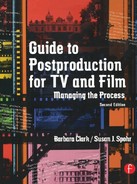Welcome to the second edition of our book, where we introduce you to the wonderful, wacky, unpredictable, fun, funny, and stressful world of film and television. You’ll love it and you’ll curse it. But, ultimately we hope to help you enjoy it as much as we do.
In this book we focus on the postproduction aspects of making movies and television programs. Postproduction encompasses all steps that take place between production and final delivery. The person who manages this process is called a postproduction supervisor or associate producer. While geared toward these positions, producers, line producers, and those just learning the business will also find this book essential.
Postproduction is a job that, if done well can be both personally and financially rewarding. If done badly, can be miserable (although you may still be rewarded financially—it’s a funny business that way).
We have organized this book with the hope of making it nearly idiot proof. Making it completely idiot proof seemed silly because then any old idiot could do it and pandemonium would surely erupt. You’d have idiots running around playing associate producers and producers, moving upward to becoming executives…. Wait! This is a little to much like art imitating life. Let’s just say that we tried to write a book that will help those who use it.
In this, the second edition of our book, we have made some changes and added some very useful new information. It’s been four years since the first edition hit the stands and a lot has changed. Advances have been made in our business of postproduction that you need to know.
You’ll find the following changes and updates as you read through this edition.
This chapter has been expanded to include more information on feature postproduction for those responsible for completing and delivering movies for theatrical distribution, be it delivery of conventional film or for the new digital cinema.
Chapter 2, Budgeting:
The budget chapter is full of good tips and guides outlining what to include in a postproduction budget and how to direct costs and avoid common mistakes. Our readers have told us they are looking for even more guidance to help with actually gathering vendor bids and plugging in the numbers. Even though we still can’t provide exact figures (it is impossible to make generalizations about how much things cost), we have provided more specific guidelines to help anyone putting together a postproduction budget.
Chapter 3, Digital TV & High Definition:
Digital Transmission of television signals and the amazing resolution of high definition videotape are two items that have become integral parts of postproduction. This chapter explains the differences between digital television and high definition television, along with their benefits and drawbacks. It also gives the Federal Communications Commission’s (FCC) plan for implementing the rollout of this technology.
Chapter 4, The Film Laboratory:
Next we move onto the film laboratory. A very complete chapter in its own right, you might wonder what else we could include.
Even though some may decry that the end of film is coming, the laboratory business just does not bear that out—at least not yet. Sure, we’re seeing more material shot with high definition cameras and effects created digitally, instead of optically in the lab. For the most part, most major motion pictures are still shot on old, dependable film. But, to keep up with the changing expectations of moviegoers and the advances in film processes, many filmmakers (even independents) are incorporating some pretty creative “film processes” into their moviemaking. Steps that call for special baths, silver washes, etc. are referred to as “special handling” in the lab. We’ll discuss these lab options so you will understand what to order and budget for when the cinematographer or director requests them as part of your dailies film processing.
We’ve also added a more detailed section on film damages—how to recognize and understand different types of damage, causes, cures, and preventions. Your film negative is your most precious asset and when the unthinkable happens, often the only thing that saves you is quick thinking and a thorough understanding of your options.
YCMs (yellow/cyan/magenta): We’ve added a section in this chapter explaining what color separations are and how and when to generate them. YCMs or color separations are the most trusted and proven elements for film preservation and archive. Many years ago, movie studios were more apt to create YCMs for their movies as a means of preservation. These were stored in climate-controlled vaults or the various salt mines around the country used for this purpose. Then sometime 20 or 30 years ago, studios stopped spending the extra money to create these film elements for every film and many films have been lost or severely damaged without any backup materials with which to recreate the negatives.
Fortunately, YCMs are coming back into style as studios and producers realize what a valuable and long-term marketable commodity they have in their motion picture assets. Also, the loss of many films considered “classics” has helped reinforce the fact that special care must be taken to preserve these cultural records of our history for generations to come.
As film stocks change and improve, handling procedures for film (especially exposed, unprocessed negative) must change. This is further enhanced by the tragic events of September 11, 2001, which resulted in increases in airport security and the use of more and more powerful x-ray equipment.
We provide information on the best ways to ship your exposed and unexposed film stock.
Chapter 5, Dailies:
Several years ago, many nontheatrical shows started shooting their images protected for possible projection in the 16 × 9 aspect ratio. This was a preemptive strike against the inevitable beginning of digital and high definition broadcast TV, which adopted 16 × 9 as its aspect ratio. The change was made even though broadcast was still in 4 × 3 (the shape of almost all consumer TVs and monitors sold, even today).
High definition (HD) has finally found a slightly more stable and promising place in the consumer marketplace. With the FCC edict that all networks broadcast at least some primetime programming in HD, productions have been forced to deal with delivering material appropriate for high definition, 16 × 9 and digital broadcasting.
In the previous edition of this book, we did sprinkle 16 × 9 wherever appropriate but didn’t include HD because there wasn’t anything very definitive to write about. Now there is. So it’s here in this edition. We start in Chapter 3 and then continue here, in the Dailies chapter, explaining about HD dailies and then bring it up again wherever it applies throughout the book. This is designed to both educate you, the reader, and help you make efficient and informed decisions throughout the postproduction of your show.
Another area of the dailies process that has evolved is the concept of “tapeless” dailies. Transferring your daily footage from either film or videotape to a hard drive or disk storage system. As computer hard drive and disk storage space costs decrease, the use of this process will increase. We’ll walk you through some of the more popular scenarios.
New distribution systems for dailies and other postproduction elements have surfaced and become more economically and logistically viable. We’ll discuss some of those systems and information distribution options for you.
Chapter 6, Editorial (Film Editorial and Video Off-Line Editing):
We still find there is sometimes confusion between what constitutes “off-line” and how it differs from the “on-line” process. We are often asked to explain these two steps in the postproduction process. Therefore, we added a more detailed definition of these two processes in hopes of further unraveling the mystery that continues to surround them.
Changes in the way some dailies are handled (for example, high definition or tapeless systems), are impacting the editorial process and how your editors will handle, log, and use the dailies materials. We have expanded this section to explain these changes and their impact on the postproduction of your project.
There is also a new section on desktop editing and some of the new methods and equipment that are being employed.
Chapter 7, On-Line Editing:
As with off-line, we have provided a more detailed explanation of the on-line process and what its role really is in the completion of your project.
In addition, high definition posting has brought about high definition on-line. So, read on as we walk you through what is available now and how that is changing the way some productions are posted.
Chapter 8, Sound:
As the foreign sales market continues to explode on all fronts, creating and delivering materials to service that market have become a standard place for the postproduction manager. To aid in this new challenge, we have added in-depth sections in this chapter to help you with such items as what is a foreign laugh pass and how you make one. Also, we tell you how to make materials for foreign language dubbing and what to do if you have to create foreign language tracks.
As with video, new sound recording formats have come on the scene. Some of them are an improvement; some bring with them added costs and concerns for the postproduction team. We cover some of the more popular elements that may be offered to you by your sound facility.
In addition to new physical sound formats, there are also additional sound formats such as 5.1 and DolbyE for which we provide definitions and instructions on mixing.
Chapter 9, Completion:
This has always been a big chapter that includes many important steps necessary to complete your project—whether it be film or video. However, we think we can be even more helpful by providing additional information on such items as film opticals (the hows and whens), AB printing, formatted dupes, etc. Film-out is also a reality for some projects that create all, or some, of their picture elements using computers or video and then need to generate film elements of these pieces. If this applies to you, you can now turn to the this chapter and find the answers you need.
This is a chapter where we have also included high definition information, where needed.
Theatrically, e-cinema or digital cinema is becoming more prevalent—especially in larger markets. The steps taken to complete your movie for a digital cinema release differ from the traditional film laboratory processes. We provide a step-by-step guide to help you create materials for digital cinema distribution.
Chapter 10, Delivery:
At this point in your project, you have too much invested to drop the ball at the eleventh hour. Follow the guidelines in this chapter to ensure your materials reach the right person at the right place and at the right time. In this edition, we’ve expanded the existing checklists, paper trail tips, sample formats, and letters to include new elements and distribution outlets.
Chapter 11, Legal:
How do you know when you need to consult an attorney? Well, we give you guidelines, tips, and even specific situations to help you make this decision. So, even though this chapter appears at the end of the book, you may want to peruse it at the beginning of your project.
Chapter 12, Acquisition:
Acquisitions are products which are “acquired”—stuff that, whether you made it or not—you are now responsible for either delivering or distributing. Several factors such as budgets, experience, and multiple distributors make this type of product very unique in both the completion and distribution areas. Read this chapter and learn the pitfalls before they trip you up; and avoid some very common mistakes that mean less money for the producers and even a cancelled schedule.
Without the aid of a crystal ball, we’ve pulled together our thoughts of what is ahead for postproduction. Then we coupled that with the opinions of others in our business who we work closely with. This chapter is the culmination of all of the opinions, plus some facts about technology that is currently being worked with in both R&D and in limited application in the real world. Time will tell how closely we’ve called it.
In the first chapter, Scheduling, we’ve laid out the steps necessary to post a show and the order in which to complete those steps. The subsequent chapters then explain each of the steps in detail.
In each chapter, we cover the three possible scenarios of postproduction: shooting and finishing on film, shooting on film and finishing on videotape, and shooting and finishing on videotape. We also provide all of the steps you will be required to complete to deliver your product both domestically (in the United States) and internationally. As you read, you will learn about budgets and how costs are calculated, what happens to film when it disappears into the chemical bowels of the film laboratory, how to set-up and manage a cutting room, how to plan and carry-out cost-effective on-lines, color correction, and titling sessions. There are numerous anecdotes throughout to help illustrate points and aid you in avoiding expensive and embarrassing mistakes. And, sometimes just to entertain.
Figures I.1 to I.4 are a series of flowcharts to help illustrate the paths that each method of postproduction will travel.
Shows that use the process in Figure I.1 are feature films, high profile, large budget TV and cable movies, and a few large budget TV series.
Figure I.1 Film Shoot to Film Finish
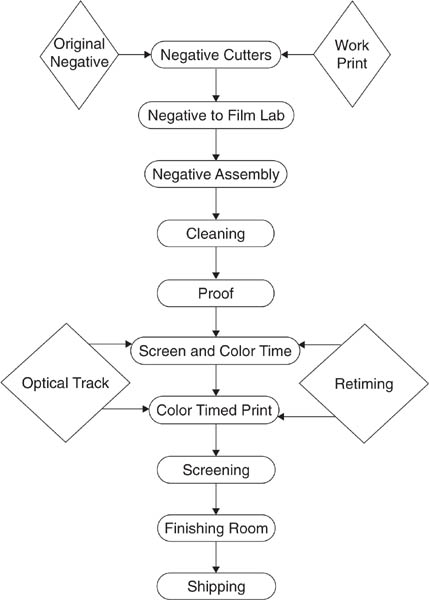
Shows that use the process in Figure I.2 are shot on film and posted on videotape, for commercials, student projects, TV series, straight-to-video movies, and documentaries.
Figure I.2 Film Shoot and Videotape Finish
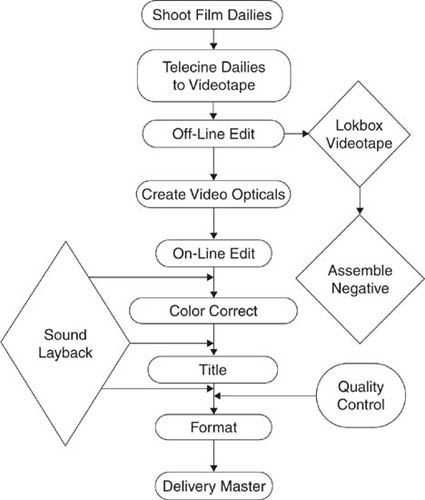
Shows that use the process in Figure I.3 are shot on vide and posted on videotape, for commercials, student projects, TV series, straight-to-video movies, and documentaries.
Figure I.3 Videotape Shoot to Videotape Finish
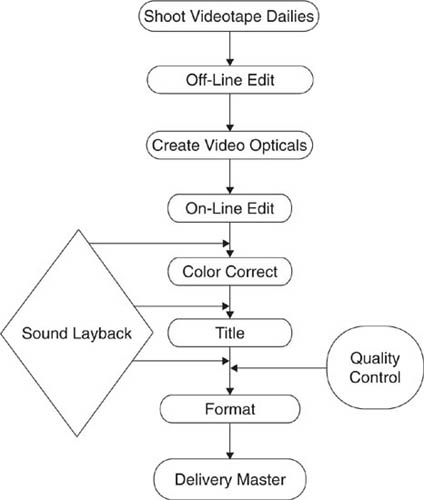
Figure I.4 Creating an Electronic Negative Flowchart
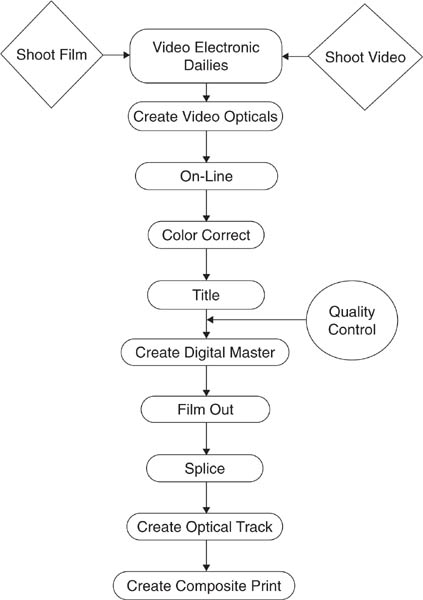
Something else we’ve added is organizational charts of the various postproduction and show managers and crew. Figures I.5 and I.6 illustrate the reporting structure for these jobs. Bullet point lists highlighting the responsibilities of each position follow these. There may be other jobs assigned to these positions, depending on the size of the project and the budget. But, this should give you a fair idea of what you can expect to be assigned to should you take one of these jobs.
Figure I.5 Management and Crew Flowchart
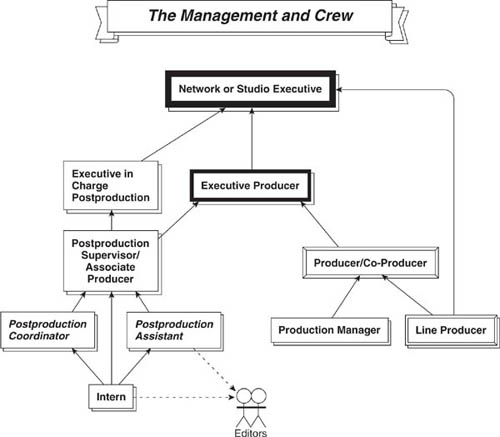
Executive Producer/Co-Executive Producer
• |
Answers to the Network or Studio Executive |
• |
Ultimately responsible for completion of the project |
• |
Concentrates on the business end of the project and assumes the financial responsibility |
• |
Usually has little time to offer input into technical issues |
• |
May be the owner or head of the production company |
• |
May have multiple shows in production simultaneously |
• |
A show may have more than one executive producer |
Producer/Co-Producer
• |
Answers to the Executive Producer |
• |
Works with attorneys to determine distribution license fees and contract details with distributors |
• |
Has creative input |
• |
Has budgetary authority |
• |
A member of the project team from pre-production through delivery |
• |
Works on one show at a time |
Line Producer
• |
Answers to the Executive Producer and/or the Producer |
• |
Works closely with the Production Manager during principal photography |
• |
Works on the budget and production schedule for principal photography and probably second unit |
• |
On smaller projects the Production Manager may assume this role and be listed as Line Producer in the credits |
• |
Works on one show at a time |
Production Manager
• |
Answers to the Producer |
• |
Responsible for budgeting |
• |
Responsible for scheduling |
• |
Supervises all day-to-day production-related activities |
• |
Is on a project from pre-production through the end of principal photography |
• |
Usually works on one series or movie at a time |
• |
This is often a union position |
Executive in Charge of Postproduction
• |
A studio or network executive |
• |
Provides list of studio or network delivery requirements |
• |
Oversees creation of delivery materials |
• |
Has little creative authority |
Postproduction Supervisor/Associate Producer
• |
Answers to the Producer and Executive in Charge of Postproduction |
• |
Manages all aspects of postproduction, including budgeting, scheduling, editing, sound, mixing, and color-correction |
• |
Creates and delivers final elements to the distributor(s) |
• |
May have some creative input |
Postproduction Coordinator
• |
Answers to the Post Production Supervisor and the Producer |
• |
Works closely with the editors |
• |
Coordinates mountains of paperwork and all film/tape/audio materials |
• |
Keeps track of stock footage and its paperwork |
• |
A key source of communication during postproduction |
• |
Record keeper for the postproduction department |
• |
Manages materials movement |
Postproduction Assistant
• |
Answers to the Postproduction Supervisor |
• |
General assistant to the Postproduction Supervisor |
• |
Assists editorial crew by filling in when editorial assistant or production assistant is not available |
• |
Helps to track down, and coordinates movement, of stock footage, special effects elements, and other materials |
• |
May be responsible for the boxing and inventory of delivery elements |
Intern
• |
Answers to the Postproduction Supervisor and editorial staff |
• |
Helps the postproduction staff wherever needed |
• |
May be paid a token salary or work for college credits |
• |
This is an entry-level position |
Figure I.6 Postproduction Staff Flowchart
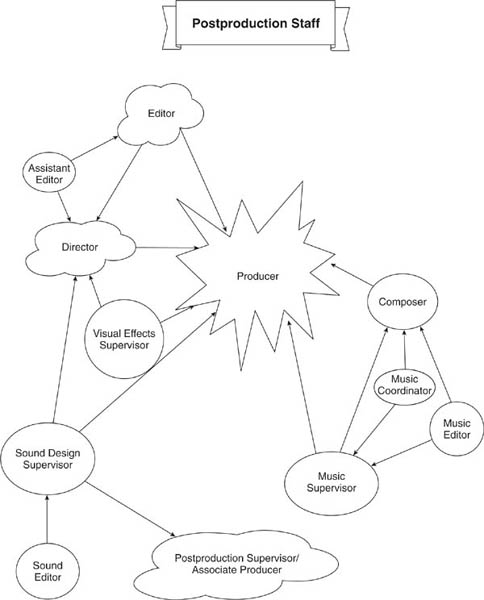
Editor
• |
Answers to the Producer and the Director |
• |
Responsible for editing the dailies together, creating the Editor’s Cut |
• |
Has extensive creative input |
• |
This may be a union position |
Assistant Editor
• |
Answers to the Editor and the Director |
• |
Synchronizes, digitizes (enters sound and picture information into the hard drive of the computer), and logs the dailies materials (picture and track) |
• |
Catalogues and tracks all elements for the editor (i.e., negative, dailies videotapes, sound, print dailies, stock footage, script notes, and any other necessary materials) |
• |
Stays on payroll through delivery to help box and catalogue delivery materials |
• |
There may be one or more assistants on a project |
• |
This may be a union position |
Sound Design Supervisor
• |
Answers to the Producer, the Director, and the Post Supervisor |
• |
Works closely with the Editor |
• |
Responsible for supervising creation of the final sound elements that make the finished sound track |
Sound Editor
• |
Works for the Sound Design Supervisor |
• |
Cuts the audio track to match picture utilizing all the sound elements including effects, production audio, and ADR |
• |
Prepares the audio materials for the sound mix |
Music Supervisor
• |
Answers to the Producer, the Composer, and the Post Supervisor |
• |
Coordinates creation of the musical score |
• |
Prepares the visual materials and cue timings for the Composer |
• |
Supervises music mixdown for dub |
• |
Coordinates materials for the sound mix |
Recommends and purchases prerecorded musical material |
|
• |
May also act as Music Editor |
• |
May be a union position |
Music Editor
• |
Works for the Composer and with the Music Supervisor |
• |
Prepares and cuts the musical score and purchased musical cues |
• |
Attends music mixdown |
Music Coordinator
• |
Works for the Composer and Music Supervisor |
• |
Coordinates purchase of prerecorded music cues |
• |
Assists composer with duplication of sheet music and other administrative duties |
• |
May also be the Music Supervisor |
Visual Effects Supervisor
• |
Answers to the Producer and the Director |
• |
Works with the Picture Editor and Postproduction Supervisor |
• |
Keeps detailed records of all components used in building visual effects |
• |
Creates visual effects budget |
• |
Supervises the entire effects |
How to Use This Book
You can utilize this book in two ways. You can sit down and read it cover to cover. When you are done, you will know postproduction. You can also use this book as a reference to guide you through each phase of your job as needed.
We hope this literary effort gives you aid and comfort on your journey through the postproduction maze. The twists and turns can seem confusing but with our help, you can make it through to the end.
We have guided many TV movies, dramas, situation comedies, and specials through these steps. Along the way, we made mistakes, some expensive, some just embarrassing. The information in this book is necessary for successful film and video postproduction. There is humor in this book because we believe that to do this job, it is essential to keep the job in perspective. And, keeping a sense of humor helps.
We recommend hard work and above all, have fun! This job demands hard work, so remembering to have fun can be the hard part.
